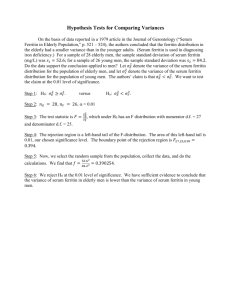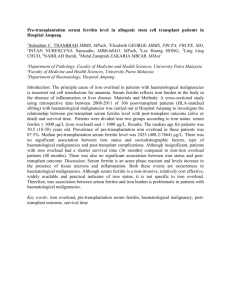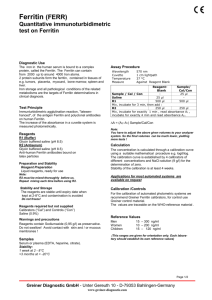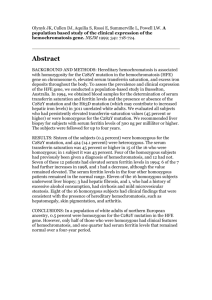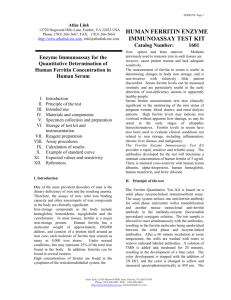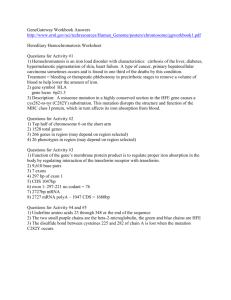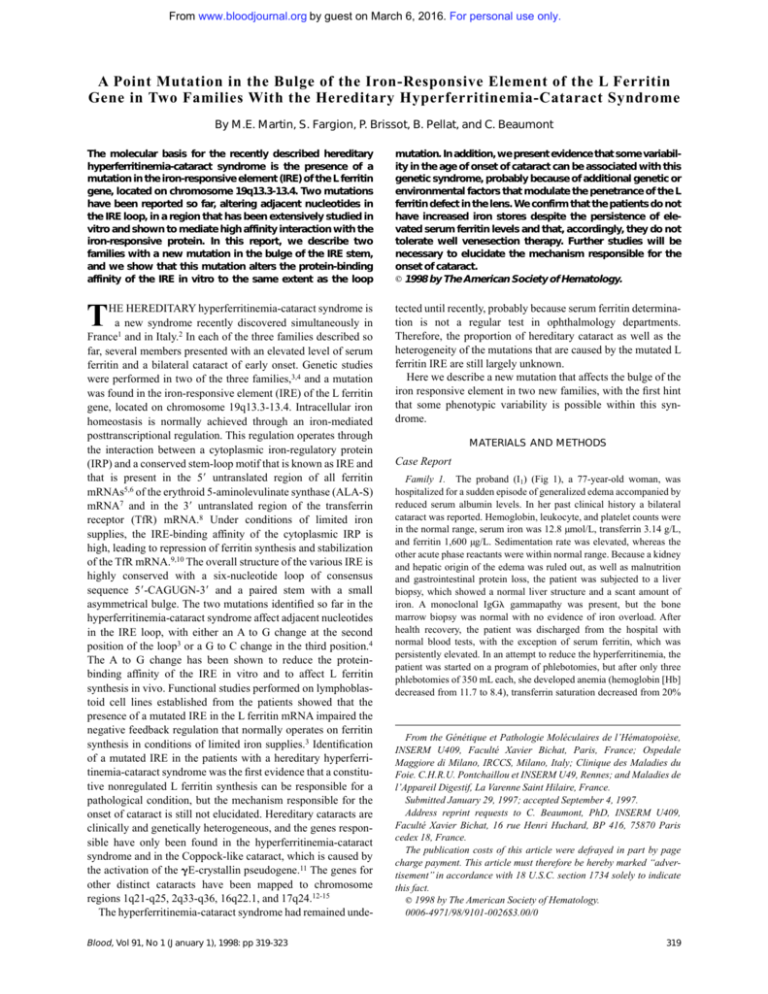
From www.bloodjournal.org by guest on March 6, 2016. For personal use only.
A Point Mutation in the Bulge of the Iron-Responsive Element of the L Ferritin
Gene in Two Families With the Hereditary Hyperferritinemia-Cataract Syndrome
By M.E. Martin, S. Fargion, P. Brissot, B. Pellat, and C. Beaumont
The molecular basis for the recently described hereditary
hyperferritinemia-cataract syndrome is the presence of a
mutation in the iron-responsive element (IRE) of the L ferritin
gene, located on chromosome 19q13.3-13.4. Two mutations
have been reported so far, altering adjacent nucleotides in
the IRE loop, in a region that has been extensively studied in
vitro and shown to mediate high affinity interaction with the
iron-responsive protein. In this report, we describe two
families with a new mutation in the bulge of the IRE stem,
and we show that this mutation alters the protein-binding
affinity of the IRE in vitro to the same extent as the loop
mutation. In addition, we present evidence that some variability in the age of onset of cataract can be associated with this
genetic syndrome, probably because of additional genetic or
environmental factors that modulate the penetrance of the L
ferritin defect in the lens. We confirm that the patients do not
have increased iron stores despite the persistence of elevated serum ferritin levels and that, accordingly, they do not
tolerate well venesection therapy. Further studies will be
necessary to elucidate the mechanism responsible for the
onset of cataract.
r 1998 by The American Society of Hematology.
T
tected until recently, probably because serum ferritin determination is not a regular test in ophthalmology departments.
Therefore, the proportion of hereditary cataract as well as the
heterogeneity of the mutations that are caused by the mutated L
ferritin IRE are still largely unknown.
Here we describe a new mutation that affects the bulge of the
iron responsive element in two new families, with the first hint
that some phenotypic variability is possible within this syndrome.
HE HEREDITARY hyperferritinemia-cataract syndrome is
a new syndrome recently discovered simultaneously in
France1 and in Italy.2 In each of the three families described so
far, several members presented with an elevated level of serum
ferritin and a bilateral cataract of early onset. Genetic studies
were performed in two of the three families,3,4 and a mutation
was found in the iron-responsive element (IRE) of the L ferritin
gene, located on chromosome 19q13.3-13.4. Intracellular iron
homeostasis is normally achieved through an iron-mediated
posttranscriptional regulation. This regulation operates through
the interaction between a cytoplasmic iron-regulatory protein
(IRP) and a conserved stem-loop motif that is known as IRE and
that is present in the 58 untranslated region of all ferritin
mRNAs5,6 of the erythroid 5-aminolevulinate synthase (ALA-S)
mRNA7 and in the 38 untranslated region of the transferrin
receptor (TfR) mRNA.8 Under conditions of limited iron
supplies, the IRE-binding affinity of the cytoplasmic IRP is
high, leading to repression of ferritin synthesis and stabilization
of the TfR mRNA.9,10 The overall structure of the various IRE is
highly conserved with a six-nucleotide loop of consensus
sequence 58-CAGUGN-38 and a paired stem with a small
asymmetrical bulge. The two mutations identified so far in the
hyperferritinemia-cataract syndrome affect adjacent nucleotides
in the IRE loop, with either an A to G change at the second
position of the loop3 or a G to C change in the third position.4
The A to G change has been shown to reduce the proteinbinding affinity of the IRE in vitro and to affect L ferritin
synthesis in vivo. Functional studies performed on lymphoblastoid cell lines established from the patients showed that the
presence of a mutated IRE in the L ferritin mRNA impaired the
negative feedback regulation that normally operates on ferritin
synthesis in conditions of limited iron supplies.3 Identification
of a mutated IRE in the patients with a hereditary hyperferritinemia-cataract syndrome was the first evidence that a constitutive nonregulated L ferritin synthesis can be responsible for a
pathological condition, but the mechanism responsible for the
onset of cataract is still not elucidated. Hereditary cataracts are
clinically and genetically heterogeneous, and the genes responsible have only been found in the hyperferritinemia-cataract
syndrome and in the Coppock-like cataract, which is caused by
the activation of the gE-crystallin pseudogene.11 The genes for
other distinct cataracts have been mapped to chromosome
regions 1q21-q25, 2q33-q36, 16q22.1, and 17q24.12-15
The hyperferritinemia-cataract syndrome had remained undeBlood, Vol 91, No 1 (January 1), 1998: pp 319-323
MATERIALS AND METHODS
Case Report
Family 1. The proband (I1) (Fig 1), a 77-year-old woman, was
hospitalized for a sudden episode of generalized edema accompanied by
reduced serum albumin levels. In her past clinical history a bilateral
cataract was reported. Hemoglobin, leukocyte, and platelet counts were
in the normal range, serum iron was 12.8 µmol/L, transferrin 3.14 g/L,
and ferritin 1,600 µg/L. Sedimentation rate was elevated, whereas the
other acute phase reactants were within normal range. Because a kidney
and hepatic origin of the edema was ruled out, as well as malnutrition
and gastrointestinal protein loss, the patient was subjected to a liver
biopsy, which showed a normal liver structure and a scant amount of
iron. A monoclonal IgGl gammapathy was present, but the bone
marrow biopsy was normal with no evidence of iron overload. After
health recovery, the patient was discharged from the hospital with
normal blood tests, with the exception of serum ferritin, which was
persistently elevated. In an attempt to reduce the hyperferritinemia, the
patient was started on a program of phlebotomies, but after only three
phlebotomies of 350 mL each, she developed anemia (hemoglobin [Hb]
decreased from 11.7 to 8.4), transferrin saturation decreased from 20%
From the Génétique et Pathologie Moléculaires de l’Hématopoièse,
INSERM U409, Faculté Xavier Bichat, Paris, France; Ospedale
Maggiore di Milano, IRCCS, Milano, Italy; Clinique des Maladies du
Foie. C.H.R.U. Pontchaillou et INSERM U49, Rennes; and Maladies de
l’Appareil Digestif, La Varenne Saint Hilaire, France.
Submitted January 29, 1997; accepted September 4, 1997.
Address reprint requests to C. Beaumont, PhD, INSERM U409,
Faculté Xavier Bichat, 16 rue Henri Huchard, BP 416, 75870 Paris
cedex 18, France.
The publication costs of this article were defrayed in part by page
charge payment. This article must therefore be hereby marked ‘‘advertisement’’ in accordance with 18 U.S.C. section 1734 solely to indicate
this fact.
r 1998 by The American Society of Hematology.
0006-4971/98/9101-0026$3.00/0
319
From www.bloodjournal.org by guest on March 6, 2016. For personal use only.
320
to 5%, but serum ferritin did not change. A family study was performed,
and two sons and a grandchild were tested.
The elder son (II1), 52 years old, did not have any pathological report
but did have a bilateral cataract that had been operated on 10 years
before. All his tests were normal (serum iron 21.4 µmol/L and
transferrin 2.1 g/L), but his ferritin was 1,200 µg/L. He was phlebotomized, and after six phlebotomies Hb turned from 15.6 to 13, transferrin
saturation decreased, and serum ferritin did not vary. Later, the patient
moved to another city and he was again subjected to several phlebotomies for the high values of ferritin and consequently developed a severe
anemia without any modification of ferritin values. He was also
subjected to liver biopsy, which showed a completely normal liver
without evidence of iron or inflammatory cells. However, some
granular, yellowish pigment of unknown composition was also observed. His 16-year-old daughter was examined; blood cell counts and
iron indices were all in the normal range. The younger son (II2), 45
years old, had increased serum ferritin (2,264 µg/L) and a normal
transferrin saturation. He was subjected to 14 phlebotomies, once a
week, with a decrease of Hb from 15 to 12.5 g/dL, a decrease of
transferrin saturation, but no modification of ferritin levels. He had no
history of cataract, and a recent control ruled out the presence of
cataract.
Family 2. The proband (III1) (Fig 1), a 24-year-old woman whose
sole previous medical problem was a bilateral cataract, presented in
1995 with constant hyperferritinemia. This biochemical abnormality
was detected in the frame of a family study initiated from her sister who
had been suspected from having genetic hemochromatosis. She was
otherwise clinically asymptomatic. Serum ferritin levels ranged between 1,250 and 1,400 µg/L (upper normal limit 250). Serum iron was
normal (16 to 19 µmol/L), and transferrin saturation (19% to 28%)
slightly decreased. Blood cell counts, sedimentation rate, serum hepatic
enzyme activities (aspartate transaminase [AST], alanine transaminase
[ALT], g-glutamyl transferase [GGT]) were normal. Liver biopsy
showed no abnormalities, and particularly Perl’s staining was negative.
Her family members presented as follows: (1) her mother (II1) had a
bilateral congenital cataract and hyperferritinemia; (2) her maternal
grandfather had a bilateral cataract; (3) her brother (III2) had a bilateral
cataract, no serum ferritin could be checked; and (4) her sister (III3),
born in 1953, had been explored in 1993 to 1994 for chronic
hyperferritinemia discovered after a malaise in 1992. Serum ferritin
levels were comprised between 1,025 and 1,330 µg/L, with erythrocyte
ferritin at 182 attograms (ag)/cell (normal range 5 4 to 28 ag/cell).
Serum iron was 22.8 µmol/L, and transferrin saturation was 35%. Hb
was 14.2 g/dL, and MCV 93.8 fL. The liver biopsy showed no iron
deposition. A few venesections were performed, but they were poorly
tolerated with rapid appearance of microcytic anemia (Hb, 10.5 g/dL;
MCV, 84 fL). The patient had been operated on for a left cataract and
presented a mild right cataract.
Genomic DNA Analysis
Genomic DNA was extracted from blood samples collected on
citrate-EDTA and subjected to polymerase chain reaction (PCR)
amplification. A first round of amplification was performed using
Lprom and Lex2 (see below) as 58 and 38 primers, and 30 cycles with
95°C for 30 seconds, 58°C for 30 seconds, and 72°C for 1 minute. The
resulting 610-bp fragment was then purified on agarose gel and further
amplified using seminested primers (Lex1 and Lex2), mapping to exon
1 and 2. The resulting 570-bp fragment was purified and sequenced.
Primers used for PCR amplification were (see Fig 2A): Lprom: 58
CGGCGCACCATAAAAGAAGCC (upper primer); Lex2: 58 GCTGGTTTTGCATCTTCAG (lower primer); and Lex1: 58 AGTTCGGCGGTCCCGCGGGTC (upper primer).
MARTIN ET AL
Fig 1. Pedigree of two families with the hereditary hyperferritinemia-cataract syndrome. Within each symbol, the left part indicates serum ferritin level and the right part the lens status. Serum
ferritin levels are indicated in micrograms per liter. A question mark
denotes an unknown serum ferritin level. Probands are identified by
an arrow.
Gel Retardation Assay
Labeled RNAs were transcribed in vitro from oligonucleotide
template using T7 RNA polymerase, as previously described.3 The
oligonucleotide used to synthesize the normal L ferritin IRE probe was:
58 TGTTCCGTCCAAACACTGTTGAAGCAAGAGACA-TCGCCCTATAGTGAGTCGTATTAGCC. The sequence of the oligonucleotide used to synthesize the mutated IRE probes differed by substituting a
C to a T at position 17 (mut1) and an A to a C at position 25 (mut2) from
the 58 end of the oligonucleotide. The underlined sequence represents
the T7 RNA polymerase promoter and was double-stranded in the
transcription reaction with an oligonucleotide complementary to this
region. The RNA used as a probe was labeled with 32P-UTP to a specific
activity of approximately 106 cpm/ng. The RNA used as a competitor
was trace-labeled with 35S-UTP to a specific activity of 500 to 200
cpm/ng. Cytoplasmic extracts were prepared from the human K562
erythroleukemia cell line.
Gel retardation assays were performed by incubating 5 µg of K562
cytoplasmic extracts treated with b-mercaptoethanol, with 50,000 cpm
of 32P-labeled IRE at room temperature for 30 minutes. Low affinity
interactions were removed by a further incubation with 5 mg of heparin
per mL for 10 minutes. Electrophoresis of RNA-protein complexes was
performed on 6% nondenaturing polyacrylamide gel in 0.5 3 TBE
(acrylamide/Bis ratio 60:1) for 2 hours.
RESULTS
We performed PCR amplification of genomic DNA from
affected members of both families. Two rounds of PCR with a
different primer pair were necessary to avoid the amplification
of the ferritin L subunit intronless pseudogenes.16 A first round
was performed using a sense primer mapping to the proximal
promoter region of the L ferritin gene and an antisense primer
mapping to exon 2. The resulting 610-bp fragment was gelpurified, and a nested PCR was performed using a combination
of oligonucleotides mapping to the beginning of exon 1 and to
exon 2. Sequencing of the PCR fragment revealed that affected
members were heterozygous for a point mutation, consisting in
a G to T transition in the bulge of the IRE (Fig 2B and C).
To confirm that the mutation was responsible for a reduced
binding affinity of the IRE to the IRP, we performed gel
retardation assay. Normal and mutated sense RNA probes were
generated by in vitro transcription in the presence of 32P-UTP.
From www.bloodjournal.org by guest on March 6, 2016. For personal use only.
BULGE MUTATION IN HEREDITARY HYPERFERRITINEMIA-CATARACT SYNDROME
321
Fig 2. Identification of the mutation in the IRE of
the L ferritin gene. (A) Schematic representation of
the functional L ferritin gene on chromosome 19q13.3q13.4 and position of the primers used for the PCR
amplification. (B) Sequence analysis of genomic DNA
from a normal individual (left) and from patient III1 in
Family 2 (right). Comparison of the sequence of the
reverse strand reveals a C to A mutation at the
heterozygous state in the patient DNA. (C) Predicted
secondary structure of the IRE in the L ferritin mRNA
and position of the mutation in the 58 UGC bulge.
Numbering is from the first nucleotide in exon 1.
In the presence of K562 cytoplasmic extracts, the normal probe
generated a high-affinity protein RNA complex (Fig 3, lane 2).
Mutated probes corresponding to the previously described loop
mutation (mut1, lane 4) or to the new bulge mutation (mut2,
lane 6) did not generate any specific complex. In addition, the
IRE/IRP complex generated by the normal IRE probe was
partially displaced by a 50-fold molar excess of the cold probe
(lane 8) and almost entirely by a 100-fold excess (lane 9),
whereas similar excess of the cold probe bearing the loop
mutation (mut1, lanes 10 to 12) or the bulge mutation (mut2,
lanes 13 to 15) did not compete for binding to the normal IRE
probe.
The results confirm that the G to T mutation in the bulge of
the L ferritin IRE fully impairs the protein-binding affinity of
the IRE and is likely to be responsible for the increased serum
ferritin levels in patients of the two families and probably for
the associated cataract.
DISCUSSION
In this report, we describe a new mutation in the IRE of the L
ferritin mRNA in two families with a hereditary hyperferritinemia-cataract syndrome, one from Italy and one from France.
The first two mutations previously reported affected adjacent
nucleotides from the IRE loop, whereas the two families
Fig 3. Gel retardation assay with normal and
mutated L ferritin IRE probes. 32P-labeled L ferritin
IRE probe (5 3 104 cpm) of either normal sequence
(lanes 1, 2, and 7 to 15) or carrying the loop mutation
(mut1, lanes 3 and 4) or the bulge mutation (mut2,
lane 5 and 6) was incubated with 5 mg K562 cytoplasmic extracts. The products were analyzed by electrophoresis on nondenaturing polyacrylamide gels either as free probe (lanes 1, 3, and 5) or after incubation
with the extract only (lanes 2, 4, and 6). For the
competition studies, the normal radiolabeled IRE
probe was incubated with the extracts in the presence of a 10-, 50- or 100-fold molar excess of a cold
normal IRE probe (lanes 7 to 9) or of a cold mutated
IRE probe with a loop mutation (mut1, lanes 10 to 12)
or a bulge mutation (mut2, lanes 13 to 15).
From www.bloodjournal.org by guest on March 6, 2016. For personal use only.
322
described here have the same G to T change in the three
unpaired nucleotide bulge of the IRE. This finding suggests that
this syndrome is likely to be more frequent than was expected at
first and reinforces the idea that the presence of a mutated IRE
in the L ferritin gene, located on chromosome 19q13.3-13.4, is
responsible for the association of cataract and hyperferritinemia. In addition, the position of the mutation is the first in
vivo evidence for the key role of the bulge in the binding affinity
of the IRE, although it has been shown that the tertiary structure
of the stem-bulge region of the IRE is a critical determinant of
translational regulation by iron.17 The structure of the stem
varies between the different IREs,6 with a three-base UGC
bulge in both H and L ferritin IRE, whereas the stem of the five
IREs in the transferrin receptor mRNA and of the single IRE in
the erythroid ALA-S mRNA have a single cytosine bulge. An
extensive in vitro study performed by Henderson et al has
shown the importance for the IRE function of this highly
conserved cytosine present in the bulge of all known IREs.18
Our results present evidence that the G from the UGC bulge is
important for the IRE function in vivo and for the high-affinity
RNA protein interaction in vitro. This mutation abrogates the
base pairing between G32 and C50 (Fig 2C), which might be
necessary for the proper conformation of the IRE, as shown by
studies based on nuclear magnetic resonance (NMR) spectroscopy19 or on identification of ligands with the highest affinity for
the IRP.20 Alternately, the mutation might impair a specific point
of protein-RNA interaction, because studies using UV radiation–
induced cross-links have shown that nucleotides 31 to 43,
including the UGC bulge and most of the loop, interact with the
IRP and are likely to be buried within the active site of the
native, iron-free protein.21
In the two families reported here, seven individuals had a
known history of cataract, and whenever serum ferritin levels
were assayed, they were found to be elevated (six patients),
ranging from 1,200 to 2,200 µg/L. These values are very similar
to those reported in the family with an A to G mutation in the
loop,3 suggesting that mutations in both the loop and the bulge
affect the in vivo function of the IRE to the same extent. This is
in agreement with our in vitro studies, which show that both
mutated IREs have lost IRP-binding activity and have no ability
to compete for IRP binding to the wild-type sequence. However,
we observed a marked phenotypic variability in the age of onset
of cataract between the two families reported here, despite the
presence of the same mutation. In fact, whereas in Family 2
affected members developed cataract during the late childhood,
the patients from Family 1 showed signs of cataract around the
age of 40; surprisingly, patient II2, age 45 years, still does not
show any evidence of lens opacification, although he carries the
mutation and his level of serum ferritin is even higher than the
other members of the family (2,260 v 1,200 to 1,600). The
mechanism leading to the onset of cataract is still unknown, but
it is possible to speculate that abnormal deposits of ferritin
molecules in the successive layers of lens epithelial cells lead
progressively to lens opacification. In the case of patient II2, it is
possible that additional factors, either genetic or environmental,
modulate the penetrance of the L ferritin defect in the lens.
Further follow-up will show whether he develops cataract or
not.
Altogether, five families with the hyperferritinemia-cataract
MARTIN ET AL
have now been described, and it becomes clear that the elevated
serum ferritin levels do not reflect the presence of increased iron
stores. Whenever a liver biopsy or a bone marrow biopsy (this
report, Family 1, patient I1) was performed, there was no
increased staining for iron. Accordingly, these patients did not
tolerate well venesection therapy. It is also important to
emphasize that recently a new syndrome has been described
where patients who most often present metabolic disorders,
such as increased body mass index, hyperlipidemia, glucose
intolerance, and hypertension, have hyperferritinemia and normal transferrin saturation.22 However, contrary to the hereditary
hyperferritinemia-cataract syndrome, these patients have iron
overload and need phlebotomies. It becomes mandatory to be
aware of the existence of these two syndromes because it
appears from the few cases described so far that patients with
the hyperferritinemia-cataract syndrome may rapidly developed
severe anemia when they are phlebotomized, even if serum
ferritin does not decrease. On the contrary, the phlebotomies
will lead to a progressive reduction in the serum ferritin level in
patients with iron overload. Therefore, a strict follow-up of
these patients should be performed, including regular hemoglobin determination together with serum ferritin assay.
ACKNOWLEDGMENT
We are grateful to Dr Devidas (Service de Médecine Interne, Centre
Hospitalier de Corbeil, Corbeil-Essones, France) for kindly providing
clinical information on his patients.
REFERENCES
1. Bonneau D, Winter-Fuseau I, Loiseau MN, Amati P, Berthier M,
Oriot D, Beaumont C: Bilateral cataract and high serum ferritin: A new
dominant genetic disorder? J Med Genet 32:778, 1995
2. Girelli D, Olivieri O, De Franceschi L, Corrocher R, Bergamaschi
G, Cazzola M: A linkage between hereditary hyperferritinemia not
related to iron overload and autosomal dominant congenital cataract. Br
J Haematol 90:931, 1995
3. Beaumont C, Leneuve P, Devaux I, Scoazec JY, Berthier M,
Loiseau MN, Grandchamp B, Bonneau D: Mutation in the iron
responsive element of the L ferritin mRNA in a family with dominant
hyperferritinemia and cataract. Nat Genet 11:444, 1995
4. Girelli D, Corrocher R, Bisceglia L, Olivieri O, De Franceschi L,
Zelante L, Gasparini P: Molecular basis for the recently described
hereditary hyperferritinemia-cataract syndrome: A mutation in the
iron-responsive element of ferritin L-subunit gene (the ‘‘Verona mutation’’). Blood 86:4050, 1995
5. Hentze MW, Caughman SW, Rouault TA, Barriocanal JG, Dancis
A, Harford JB, Klausner RD: Identification of the iron-responsive
element for the translational regulation of human ferritin mRNA.
Science 238:1570, 1987
6. Theil C: Iron regulatory elements (IREs): A family of mRNA
non-coding sequences. Biochem J 304:1, 1994
7. Melefors O, Goossen B, Johansson HE, Stripecke R, Gray NK,
Hentze MW: Translational control of 5-aminolevulinate synthase
mRNA by iron-responsive elements in erythroid cells. J Biol Chem
268:5974, 1993
8. Casey JL, Koeller DM, Ramin VC, Klausner RD, Harford JB: Iron
regulation of transferrin receptor mRNA levels requires iron-responsive
elements and a rapid turnover determinant in the 3’ untranslated region
of the mRNA. EMBO J 8:3693, 1989
9. Hentze MW, Kuhn LC: Molecular control of vertebrate iron
metabolism: mRNA-based regulatory circuits operated by iron, nitric
oxide, and oxidative stress. Proc Natl Acad Sci USA 93:8175, 1996
From www.bloodjournal.org by guest on March 6, 2016. For personal use only.
BULGE MUTATION IN HEREDITARY HYPERFERRITINEMIA-CATARACT SYNDROME
10. Klausner RD, Rouault TA, Harford JB: Regulating the fate of
mRNA: The control of cellular iron metabolism. Cell 72:19, 1993
11. Brakenhoff RH, Henskens HAM, van Rossum MW, Lubsen NH,
Schoenmakers JGG: Activation of the gE-cristallin pseudogene in the
human hereditary Coppock-like cataract. Hum Mol Genet 3:279, 1994
12. Renwick JH, Lawler SD: Probable linkage between a congenital
cataract locus and the Duffy blood group locus. Ann Hum Genet 27:67,
1963
13. Lubsen NH, Renwick JH, Tsui LC, Breitman ML, Schoenmarkers JGG: A locus for a human hereditary cataract is closely linked to the
g-crystallin gene family. Proc Natl Acad Sci USA 84:489, 1987
14. Maumenee IH: Classification of hereditary cataracts in children
by linkage analysis. Ophtalmology 86:1554, 1979
15. Armitage MM, Kivlin JD, Ferrell RE: A progressive early onset
cataract gene maps to human chromosome 17q24. Nat Genet 9:37, 1995
16. Jain SK, Barrett KJ, Boyd D, Favreau MF, Crampton J, Drysdale
JW: Ferritin H and L chains are derived from different multigene
families. J Biol Chem 260:11762, 1985
17. Kikinis Z, Eisenstein RS, Bettany AJE, Munro HN: Role of RNA
secondary structure of the iron-responsive element in translational
regulation of ferritin synthesis. Nucleic Acids Res 23:4190, 1995
323
18. Henderson BR, Kuhn LC: Differential modulation of the RNAbinding proteins IRP-1 and IRP-2 in response to iron. IRP-2 inactivation requires translation of another protein. J Biol Chem 270:20509,
1995
19. Sierzputowska-Gracz H, McKenzie RA, Theil EC: The importance of a single G in the hairpin loop of the iron responsive element
(IRE) in ferritin mRNA for structure: An NMR spectroscopy study.
Nucleic Acids Res 23:146, 1995
20. Butt J, Kim HY, Basilion JP, Cohen S, Iwai K, Philpott CC,
Altschul S, Klausner RD, Rouault TA: Differences in the RNA binding
sites of iron regulatory proteins and potential target diversity. Proc Natl
Acad Sci USA 93:4345, 1996
21. Basilion JP, Rouault TA, Massinople CM, Klausner RD, Burgess
WH: The iron-responsive element-binding protein: Localization of the
RNA-binding site to the aconitase active-site cleft. Proc Natl Acad Sci
USA 91:574, 1994
22. Moirand R, Mortaji A, Loréal O, Paillard F, Brissot P, Deugnier
Y: Liver iron overload with normal transferrin saturation: A new
syndrome. Lancet 349:95, 1997
From www.bloodjournal.org by guest on March 6, 2016. For personal use only.
1998 91: 319-323
A Point Mutation in the Bulge of the Iron-Responsive Element of the L
Ferritin Gene in Two Families With the Hereditary
Hyperferritinemia-Cataract Syndrome
M.E. Martin, S. Fargion, P. Brissot, B. Pellat and C. Beaumont
Updated information and services can be found at:
http://www.bloodjournal.org/content/91/1/319.full.html
Articles on similar topics can be found in the following Blood collections
Red Cells (1174 articles)
Information about reproducing this article in parts or in its entirety may be found online at:
http://www.bloodjournal.org/site/misc/rights.xhtml#repub_requests
Information about ordering reprints may be found online at:
http://www.bloodjournal.org/site/misc/rights.xhtml#reprints
Information about subscriptions and ASH membership may be found online at:
http://www.bloodjournal.org/site/subscriptions/index.xhtml
Blood (print ISSN 0006-4971, online ISSN 1528-0020), is published weekly by the American Society of
Hematology, 2021 L St, NW, Suite 900, Washington DC 20036.
Copyright 2011 by The American Society of Hematology; all rights reserved.

